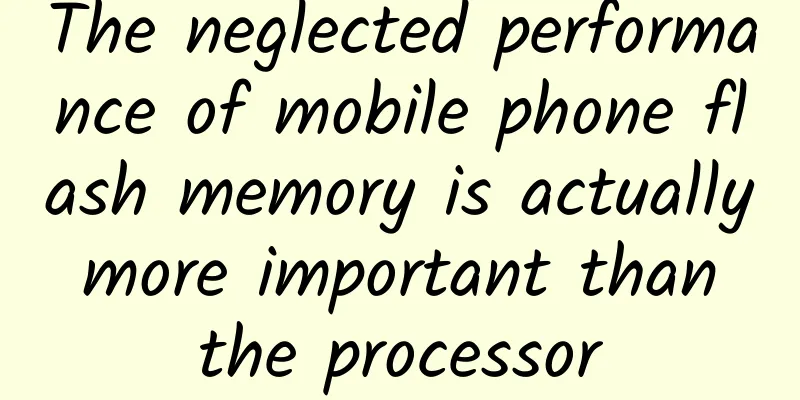The neglected performance of mobile phone flash memory is actually more important than the processor

|
In recent days, two unfamiliar words suddenly entered the vision of netizens: UFS 2.1 and eMMC 5.1. The read and write speeds of these two flash memories have become the focus of everyone's attention. I am also very pleased with this phenomenon. Long-term readers of this site should know that the read and write performance of mobile phone flash memories has always been a very important item in our evaluation, because in actual use experience, the impact of flash memory performance on the user experience is actually very large. So today, let's take a good look at the difference between UFS and eMMC. Is it worth it for everyone to toss around so much? First of all, we need to know the technical characteristics of UFS and eMMC. This site previously talked about the differences between UFS, eMMC and NVMe in an article titled "Everyone is talking about RAM and ROM, but do you really understand these storage components?" Here we will analyze them with you in plain language, and then introduce who the representative manufacturers of these technologies are, and what the mass production and cost are like. First of all, we need to know that a flash memory (what we often call ROM) is generally composed of NAND particles, a main control chip and a data interface. UFS, eMMC and NVMe actually refer to transmission protocols, which can be regarded as the main control chip and data interface parts. In fact, eMMC almost dominated the mobile market before. This standard has developed from eMMC4.3 to the current 5.1, and the transmission speed has also soared from 50MB/S to 600MB/S. However, the potential of the eMMC standard has been exhausted in recent years, so the stronger UFS and NVMe protocols have come on the scene. Because NVMe is only used in products such as iPhones in the category of mobile phones, I will not introduce it in detail here, but mainly talk about eMMC and UFS. The main difference between eMMC and UFS is that eMMC can only maintain one state of reading or writing at the same time, while UFS supports reading and writing data at the same time, and in standby mode, UFS consumes much less power. The difference in speed is even greater, with the theoretical speed of UFS 2.0 reaching 780MB/S and UFS 2.1 reaching 1.5GB/S. In terms of manufacturers and costs, eMMC is a long-established industry standard. Almost all manufacturers produce this type of flash memory, and it is cheap. Taking this week's quotations as an example, the unit prices of 32GB and 64GB eMMCs commonly used in mobile phones are US$9.8 and US$21 respectively, which is equivalent to about RMB 67 and RMB 145. Although Samsung led the R&D of the UFS protocol and has a leading position in this market, we found that SK Hynix, Micron, Toshiba and other manufacturers have launched UFS 2.0 and 2.1 flash memory, and the output is not small, so Samsung does not monopolize this market. In terms of price, the difference between UFS and eMMC flash memory is huge. We found a 64GB UFS 2.1 flash memory on Toshiba's supplier website, and the price is as high as 285 yuan, which is almost twice the price of eMMC flash memory of the same capacity! So I believe that everyone here has a certain understanding of the production and price of UFS and eMMC. Next, let’s take a look at the differences in experience that different types of flash memory will cause in actual experience. In the eyes of many people, the reading and writing speed of a mobile phone is reflected in the copying of files, so it is tolerable if it is slow. However, the actual situation is far more than this. The mobile phone experience is not entirely determined by the processor. In fact, whether the phone is stuck or not is determined by the SoC and memory, and whether it is fast or not is more determined by the flash memory speed. To give a few of the most common examples, the software installation speed, game loading speed, and the reading speed of photos and other files are all very dependent on the flash memory speed. For example, some people may find that when they quickly scroll through the album, even though they have scrolled very far down, the photo list is all black. This is because the flash memory reading and writing cannot keep up with the operation, resulting in not being able to read all the photos we swiped through in time. What the processor determines is whether the phone will freeze during this sliding process. There is also the software installation speed. Although the read and write speed of eMMC 5.1 is rated at 600MB/S, the actual test may only be 250MB/s. However, UFS 2.1 is rated at 1.5GB/s, and in actual use it reaches 750MB/s, which is three times the difference. This means that it takes three times as long to install the same application on eMMC flash memory! Similarly, the speed of loading games and application screens is also three times different. This painful waiting is as disgusting as the phone freezing. However, in the eyes of many friends who do not have high requirements for mobile phones, it is normal for the phone not to freeze, and they have never thought that the phone can actually be faster. I believe that after reading this article, you have a preliminary understanding of the importance of flash memory performance. Therefore, it is recommended that when you buy a mobile phone in the future, you should not only look at the processor strength and the size of the memory flash, but also pay attention to the flash memory transmission protocol, because the storage performance actually has a much greater impact on the user experience than SoC. Many manufacturers take advantage of the fact that consumers do not care about these deep-seated parameters. Although they provide large-capacity memory, the speed is very slow, which greatly reduces the user experience. The purpose of doing this is to save a lot of costs. We have also discussed before that the price of UFS 2.1 and eMMC 5.1 is exactly twice as different! In fact, in addition to the flash memory transmission protocol, the type of flash memory particles is also very important, and the same is true for memory (RAM). However, these two points are not the focus of everyone's concern in recent days, so we will not go into details here. Finally, I hope everyone will pay attention to these consumer traps and buy truly excellent mobile phones. As a winner of Toutiao's Qingyun Plan and Baijiahao's Bai+ Plan, the 2019 Baidu Digital Author of the Year, the Baijiahao's Most Popular Author in the Technology Field, the 2019 Sogou Technology and Culture Author, and the 2021 Baijiahao Quarterly Influential Creator, he has won many awards, including the 2013 Sohu Best Industry Media Person, the 2015 China New Media Entrepreneurship Competition Beijing Third Place, the 2015 Guangmang Experience Award, the 2015 China New Media Entrepreneurship Competition Finals Third Place, and the 2018 Baidu Dynamic Annual Powerful Celebrity. |
>>: HIMSS: 2024 Healthcare Industry Cybersecurity Survey Report
Recommend
10 Mother’s Day copywriting ideas!
This Sunday, May 13th, is Mother’s Day . Are copy...
In addition to turning into starch, what else can carbon dioxide turn into? It turns out to be rocks!
Popular Science Times (Intern Wang Yuke) Microorg...
HTC enters the 1,000 yuan 4G market, new Desire 5 series experience review
After launching the new Desire 8 series for the pr...
[Smart Farmers] Looking at the Wandering Earth from an agricultural perspective: If the Earth were wandering, what would humans eat?
Editor’s Note: The recent hit of "The Wander...
Why have we been obsessed with solving pi from ancient times to the present?
When it comes to "π", Chinese people wi...
Ultrasonic sensor helmet lets you walk like a bat
Bats, as creatures that live in darkness all year ...
Douyin operation strategy for the food industry
1. Food Industry Development Background 1. Accord...
Is this year a year of high prevalence of Mycoplasma pneumoniae? How to take azithromycin? Experts remind →
Recently, many hospitals in Beijing, Shanghai, Ch...
Xiaohongshu’s efficient strategies for increasing followers!
In just one or two months during the epidemic, th...
Is it expensive to develop a Xingtai food mini program? Xingtai Food Mini Program Development Cost List
The launch of mini programs has brought convenien...
From super TV to super car, the future life guided by LeTV
After the underlying LeTV business develops, hard...
Dismantle the virtual resource project operated through Baidu bidding. Mom can also operate it at home and earn 15,000 yuan a month
I have been operating this project for more than ...
But we only hear the voice but never see the "person". What is missing from the 4K industry chain?
Since its introduction, 4K has been one of the ho...
Welcome the God of Wealth on the 5th day of the New Year|The Gods of Wealth from ancient times to the present, all explained to you in one breath →
It is the day to welcome the God of Wealth on the...
As stock markets fall, a cold winter is coming for global technology startups
[[146858]] The New York Times online version wrot...









